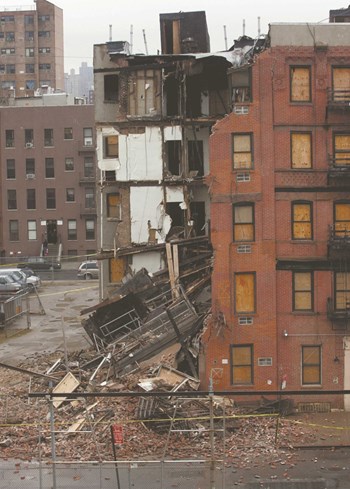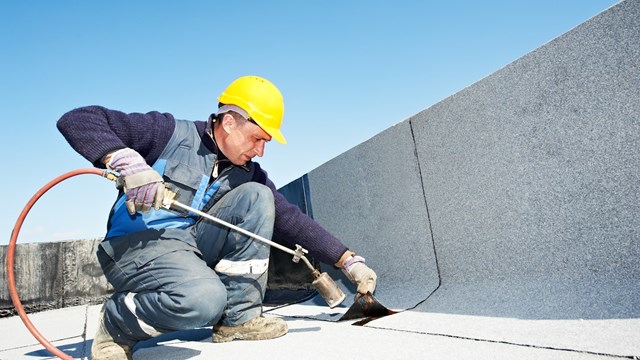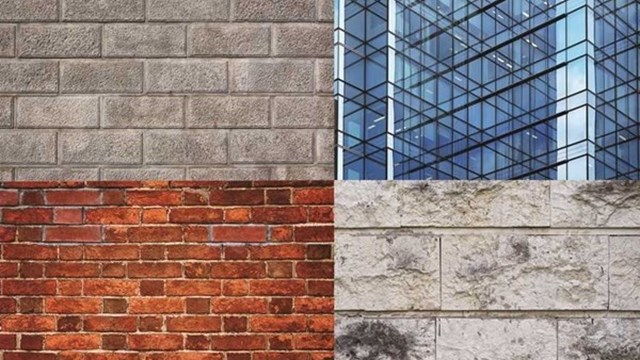
Whether a building is old or new, built of stone, brick, glass or some other material, trouble with or damage to its façade is a serious emergency. Telltale signs of building breakdown on the outside—a growing crack or crumbling mortar for example—is unintentionally advertising to potential residents that the building is, sadly, being poorly maintained. Anyone who can see the deterioration on the exterior will rightly wonder how well management is taking care of the interior.
Even more importantly, if left unattended, even seemingly minor façade issues can lead to significant damage, which in turn can lead to significant damage to your building’s bottom line. In the most tragic of circumstances, crumbling façades that ultimately collapse can cause serious injuries (or worse) to residents and bystanders.
Seal the Envelope
Before you can understand what can go wrong with a building’s façade, it’s important to understand how the building is constructed. According to Jerry Yates, chairman of Yates Restoration Group, Ltd. in the Bronx, there are two types of common building façades in the New York City area—load bearing and curtain wall.
Simply put, a load-bearing façade exists when an exterior building wall bears the weight and the force resting upon it. “One example of that type of building façade would be the European castles made 500 years ago where the stones are thick and the building doesn’t need any other support,” says Yates. “We still have some buildings in New York being built that way, but most are made of curtain wall construction.”
“Curtain wall construction is a general term that means it has a façade that doesn’t support the building,” Yates explains. “The building is supported by a steel or concrete frame instead. The whole building goes up, and the only thing missing is the façade; the façade is held up by that skeleton. The façade can be made of brick, stone, metal, or glass and is and hung off the frame and held in place by pins. Most co-op buildings are built like this.”
Unfortunately, curtain wall construction isn’t meant to last forever and can be susceptible to cracks and leaks due to simple wear-and-tear over time and/or lack of upkeep—among other problems. Signs of trouble on the outside of the building can turn up in the form of rust spots, algae formation, and cracks in the mortar, caulking and sealants.
“Nothing lasts forever—it ages and deteriorates, no matter what you do to it,” explains Yates. “Years ago, many buildings were in terrible economic straits and nobody put money into fixing them and the buildings deteriorated.”
In addition to age and lack of upkeep, another common cause of cracks and leaks is water seepage behind the curtain wall. During construction, the building’s envelope—which consists of the walls, foundation and roof—needs to be waterproofed to prevent unwanted moisture from entering and getting trapped inside the walls. While some moisture is almost always present within a building, the building needs adequate ventilation in order to dry out the moisture that does seep in. However, not all ventilation systems are adequate and, as a result, moisture will seep through.
“Some problems start when cleaning companies or supers sandblast the exterior to remove the dirt,” says Yates. “This sandblasting can start to destroy the brick and stone.”
Alex Anagnostidis, president of APA Restoration Corp. in Maspeth, says that shoddy construction, using substandard materials and a lack of attention to proper waterproofing techniques are serious issues that can lead to exterior problems.
“Brick wasn’t intended to move, but if the brick moves or the steel rusts on a building, it’s [most likely] because water got into the envelope and over time caused rust or algae,” says Yates. “When rust forms, it results in water and oxygen—an inch of steel will result in ten times that much rust—and the steel will expand.”
If your building has painted its masonry exterior, that may cause water problems too. “The moisture can’t escape and is trapped,” says Mario Sciacca, owner of Etna Contracting Inc. in Brooklyn. “Many of the newer buildings aren’t being built properly with this waterproofing membrane and that is contributing to problems. The craftsmanship of the buildings from the 1960s and 1970s was better, but today it’s about the bottom line.”
Consider the Consequences
What are some of the consequences of undetected or untreated wall or façade damage? “First, it’s extensive damage,” says Anagnostidis. “Say you’ve been putting off exterior maintenance. If these items aren’t fixed, the deterioration will continue—water gets inside the façade and behind the masonry, or the steel rusts and expands, and pushes the masonry out.”
Now, the consequences become financial. “The building that once had to fix say, $100,000 in damage now has $300,000 in damages,” he says.
And letting this deterioration get to the point where things are crumbling and falling off the building can lead to something much, much worse. Just this year, a 50-pound chunk of decorative terracotta fell from the upper story of a 25-story co-op at 45 Tudor Place in Manhattan crushing a woman’s (fortunately empty) car. A tourist suffered a fractured skull when a 25-pound ornament fell from the 14th floor of a building at Seventh Avenue and 33rd Street. An 18-year-old woman was hit in the head by a brick from the second floor of a building under renovation on the Lower East Side, and a security guard was injured when a 30-pound chunk of cast-iron façade fell off a building at Broadway and 33rd Street. And that was just between June and July.
Preventative Maintenance
In order to be considered safe, your building must comply with New York City Local Law 11, which was signed into law in 1998. This law requires that buildings undergo preventative maintenance inspections on a regular basis and imposed more stringent requirements for repair of deteriorated conditions.
Owners of buildings generally with more than six stories—within the five boroughs of the City of New York—must have the exterior walls and appurtenances inspected by a licensed professional engineer or licensed architect every five years.
“How do you make sure your façade is water tight?” asks Anagnostidis. “Hire a construction engineer to do a façade inspection—look for open water joints, cracks or missing caulking, or do a scaffold drop.”
Attorney C. Jaye Berger, a co-op/condo attorney specializing in construction law and principal of the Law Offices of C. Jaye Berger in Manhattan, says that another way to avoid façade repairs is to implement a regular preventative maintenance program as well as ongoing observation in between the inspections.
“Take care of problems as they occur and don’t wait for a critical point where you have to satisfy the report,” she says.
Sciacca remembers one building that he repaired that was built in the 1960s. “When we removed the brick, anchors on the façade were missing entirely, and it caught me by surprise,” says Sciacca. “From talking to other guys in the business, we find that this is a constant problem. The anchors are like $5 each, but who is going to control the workers? The façade wouldn’t collapse—it’s all veneer—but it’s not good.”
Anagnostidis remembers a building that had a major crack from the second all the way to the eighth floor. “It can take from weeks to months to fix a crack like that,” he says.
“It started out as a corner replacement, removing the masonry, scraping the rust and putting on an epoxy coating,” he explains. “Finishing the coating, installing an expansion joint and wrapping the structural steel with waterproofing membrane. Other anchors are installed and you lay the brick and finish the job.”
Anagnostidis explains that historic buildings—which need their own specific building materials and parts—can require much more attention to detail and can take much longer. “Sometimes you need to order parts out of the country in order to finish the job,” he says.
In the end, your building’s façade is more than just the pretty face it shows to passers-by on the street; it’s an integral component of the structure you and your residents call home, and needs to be as conscientiously maintained as the roof or foundation. With a regular inspection schedule and sound maintenance program in place, your building’s façade will remain solid and secure for many decades to come.
Lisa Iannucci is a freelance writer, and a frequent contributor toThe Cooperator.









Leave a Comment